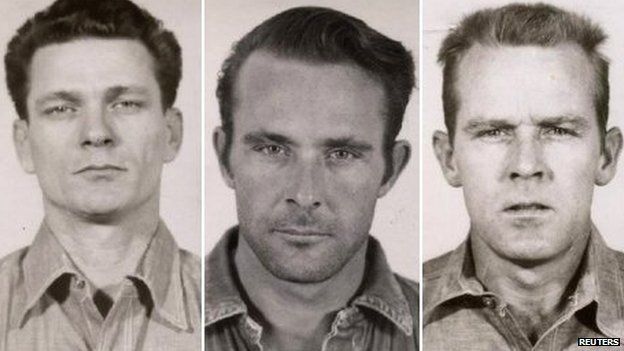Alcatraz 1962 escapees had small chance of success
- Published

Three inmates who famously escaped from the US island prison Alcatraz had a small chance of making it to land alive - but the odds were stacked against them, a new study suggests.
In 1962, the prisoners absconded using a raft, and were never seen again.
A novel computer model now indicates that if they set off right at midnight, they could have made landfall.
But if they left in the hours either side, it is very likely they died in the cold waters of San Francisco Bay.
The study was carried out by scientists at Delft University and the research institute Deltares, both in the Netherlands, and is being presented this week at the American Geophysical Union Fall Meeting, which is hosted in the California city.
Fake heads
This prison break - dramatized by Clint Eastwood in the film Escape from Alcatraz - is one of the most daring and intricate escapes ever attempted.
Three bank robbers - Clarence Anglin, John Anglin and Frank Morris - spent months digging an escape tunnel out of their concrete cells using sharpened spoons.
On the night of 11 June 1962, they left dummy heads, fashioned out of soap, toilet paper and hair, in their beds, and crawled out of the "escape-proof" prison.
At the water's edge, it is thought they made an inflatable raft out of raincoats and entered San Francisco Bay, at some point between 2000 and 0200, according to FBI files.
Despite an intense search effort, the men were never found. Whether they survived and made landfall or died after entering the water remains a mystery.
Now, a Dutch team of scientists has attempted to shed light on what happened.
Dr Rolf Hut said: "My colleague, Olivier Hoes, was working on a hydraulic model, called 3Di, which is a collaboration between different Dutch companies, agencies and universities.
"It is a high-performance hydraulic model for simulating the movement of water bodies in deltas and bays.
"He was using that to simulate the movement of water in the San Francisco Bay area, and I thought we could try to re-analyse what happened back in 1962."
Dr Hut said he was inspired to find out more by the US TV show MythBusters, in which the presenters recreated the escape and managed to make landfall.
But the Dutch scientist wanted to recreate the exact conditions of the night using historical tidal data in the computer model.
Fedor Baart, a simulation specialist at Deltares, explained: "We didn't know exactly when the inmates launched their boats, or their precise starting point, and so we decided to release 50 [virtual] boats every 30 minutes between 2000 and 0400, from a range of possible escape spots at Alcatraz to see where they would end up.
"We added a paddling effect to the boats, as we assumed the prisoners would paddle as they got closer to land."
With the help of the virtual vessels, the researchers found that if the prisoners had escaped in the hours before midnight, they would have almost certainly perished.
Dr Hut said: "In the worst-case scenario, where paddling was ineffective, the outgoing tide would have swept them out to the ocean and they would have died of hypothermia. For sure.
"The San Francisco Bay area has one of the strongest tidal currents going under the Golden Gate Bridge."
But if they entered the water later, after 1am, the tide would have reversed, taking the escapees on a different course.
Dr Hut explained: "They would have been pushed back into the Bay. And then depending on which way they were paddling, they would have been sent into the north bay - towards Berkeley and the mouth of the Sacramento River - or pushed south towards Oakland, past Treasure Island.
"In both cases they would have spent so much time in the water, they probably would have died of hypothermia, or they would have been picked up by the police because sunrise was at 0600."
However, the team found one small window where survival would have been possible.
If the trio had left at midnight and had paddled hard to the north, then the strong currents could have worked in their favour.
"If they hit it exactly at midnight, the beautiful thing is that we see that they would have been sucked out towards the Golden Gate Bridge," Dr Hut told BBC News.
"But the moment they were close to the Golden Gate would have been the moment the tide reverses.
"And that would give them a moment of slack tide, in which they could have reached marine headlands in the northern site of the Golden Gate Bridge."
The team has produced visualisations that show a "worst case scenario", in which the prisoners do not paddle, and a "best case scenario", in which they paddle northwards at a speed of 25cm per second.
Outside factors
The model also predicted that any debris from the raft would have floated back into the bay, towards Angel Island, which is where the FBI found a paddle and some personal belongings.
The team points out that the model cannot prove exactly what happened, but it does help to assess what scenarios are most plausible.
"We're just exploring possibilities within the scope of what we can calculate," said Dr Hut.
"When doing historical research, there is a chance that there is an event not in the feasibility of your model: maybe they had a friend with a boat?
"We are only exploring whether it was possible for them to make landfall, with no additional help or other events taking place."
Follow Rebecca on Twitter
- Published12 June 2012
- Published27 February 2014
- Published19 March 2013